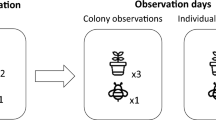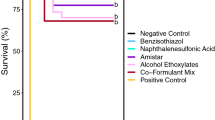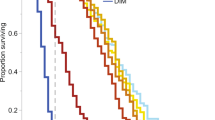Abstract
Recent research has shown that several managed bee species have specific P450 enzymes that are preadapted to confer intrinsic tolerance to some insecticides including certain neonicotinoids. However, the universality of this finding across managed bee pollinators is unclear. Here we show that the alfalfa leafcutter bee, Megachile rotundata, lacks such P450 enzymes and is >2,500-fold more sensitive to the neonicotinoid thiacloprid and 170-fold more sensitive to the butenolide insecticide flupyradifurone than other managed bee pollinators. These findings have important implications for the safe use of insecticides in crops where M. rotundata is used for pollination, and ensuring that regulatory pesticide risk assessment frameworks are protective of this species.
This is a preview of subscription content, access via your institution
Access options
Access Nature and 54 other Nature Portfolio journals
Get Nature+, our best-value online-access subscription
$29.99 / 30 days
cancel any time
Subscribe to this journal
Receive 12 digital issues and online access to articles
$119.00 per year
only $9.92 per issue
Buy this article
- Purchase on Springer Link
- Instant access to full article PDF
Prices may be subject to local taxes which are calculated during checkout


Similar content being viewed by others
Data availability
The accession numbers of the M. rotundata P450 genes analysed in this study are shown in Supplementary Table 1. All other data generated or analysed during the study are included in this published article and its Supplementary Information files.
References
Johnson, R. M. Annu. Rev. Entomol. 60, 415–434 (2015).
Beadle, K. et al. PLoS Genet. 15, e1007903 (2019).
Manjon, C. et al. Curr. Biol. 28, 1137–1143.e5 (2018).
Mao, W., Schuler, M. A. & Berenbaum, M. R. Proc. Natl Acad. Sci. USA 108, 12657–12662 (2011).
Pitts-Singer, T. L. & Cane, J. H. Annu. Rev. Entomol. 56, 221–237 (2011).
Scott-Dupree, C. D., Conroy, L. & Harris, C. R. J. Econ. Entomol. 102, 177–182 (2009).
Gradish, A. E., Scott-Dupree, C. D. & Cutler, G. C. J. Pest Sci. 85, 133–140 (2012).
Kapheim, K. M. et al. Science 348, 1139–1143 (2015).
Nauen, R. et al. Pest Manage. Sci. 71, 850–862 (2015).
Claudianos, C. et al. Insect Mol. Biol. 15, 615–636 (2006).
Edgar, R. C. Nucleic Acids Res. 32, 1792–1797 (2004).
Nei, M. & Kumar, S. Molecular Evolution and Phylogenetics (Oxford Univ. Press, 2000).
Guindon, S. et al. Syst. Biol. 59, 307–321 (2010).
Ronquist, F. et al. Syst. Biol. 61, 539–542 (2012).
OECD Guidelines for the Testing of Chemicals. Test 214. Honeybees, Acute Contact Toxicity Test (Organisation for Economic Co-operation and Development, 1998); https://www.oecd-ilibrary.org/environment/test-no-214-honeybees-acute-contact-toxicity-test_9789264070189-en
Roessink, I., van der Steen, J. J. M. & Hanewald, N. Solitary Bee, Acute Contact Toxicity Test (ICPPR Workgroup non-Apis bees, 2016).
European Food Safety Authority EFSA J. 13, 4020 (2015).
Arena, M. & Sgolastra, F. Ecotoxicology 23, 324–334 (2014).
Nauen, R., Ebbinghaus-Kintscher, U. & Schmuck, R. Pest Manage. Sci. 57, 577–586 (2001).
Wheelock, G. D. & Scott, J. G. Entomol. Exp. Appl. 61, 295–299 (1991).
Zhu, F. et al. Proc. Natl Acad. Sci. USA 107, 8557–8562 (2010).
Guidance for Assessing Pesticide Risks to Bees (United States Environmental Protection Agency, Health Canada Pest Management Regulatory Agency & California Department of Pesticide Regulation, 2014); https://www.epa.gov/sites/production/files/2014-06/documents/pollinator_risk_assessment_guidance_06_19_14.pdf
Acknowledgements
This study received funding from the Biotechnology and Biological Sciences Research Council and Bayer AG through an Industrial CASE studentship award (no. BB/P504774/1). The technical assistance of J. Hens is gratefully acknowledged.
Author information
Authors and Affiliations
Contributions
C.B. and R.N. conceived and directed the study, A.H., K.B., K.S.S. and J.G. performed the experiments and analysis. N.E., M.Z., M.-T.A., A.N. and C.G. analysed and interpreted the data. A.H., C.B. and R.N. wrote the paper with contributions from all authors.
Corresponding authors
Ethics declarations
Competing interests
This study received funding from Bayer AG, a manufacturer of neonicotinoid and butenolide insecticides. N.E., M.Z., M.-T.A., A.N., C.G., J.G. and R.N. are employees of Bayer AG.
Additional information
Publisher’s note Springer Nature remains neutral with regard to jurisdictional claims in published maps and institutional affiliations.
Supplementary information
Supplementary Information
Supplementary Tables 1 and 3.
Supplementary Table
Supplementary Table 2 Comparison of the CYPomes of 4 managed bee species.
Rights and permissions
About this article
Cite this article
Hayward, A., Beadle, K., Singh, K.S. et al. The leafcutter bee, Megachile rotundata, is more sensitive to N-cyanoamidine neonicotinoid and butenolide insecticides than other managed bees. Nat Ecol Evol 3, 1521–1524 (2019). https://doi.org/10.1038/s41559-019-1011-2
Received:
Accepted:
Published:
Issue Date:
DOI: https://doi.org/10.1038/s41559-019-1011-2
This article is cited by
-
A new exposure protocol adapted for wild bees reveals species-specific impacts of the sulfoximine insecticide sulfoxaflor
Ecotoxicology (2024)
-
Risk assessment requires several bee species to address species-specific sensitivity to insecticides at field-realistic concentrations
Scientific Reports (2023)
-
Intra-specific variation in sensitivity of Bombus terrestris and Osmia bicornis to three pesticides
Scientific Reports (2022)
-
Ornamental roses for conservation of leafcutter bee pollinators
Scientific Reports (2022)
-
Toxicity of the insecticide sulfoxaflor alone and in combination with the fungicide fluxapyroxad in three bee species
Scientific Reports (2021)



